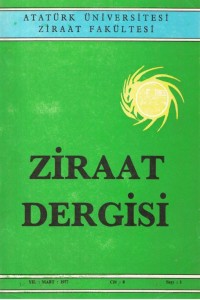Abstract
ÖZET
Bu çalışmada Erzurum, Kars ve Ağrı illerini içine alan bölgede,
insan, -koyun ve sığır serumlarında Q humması antikor durumu ve bu
hastalığın insan ve hayvanlar arasında muhtemel yayılma yolları incelenmiştir.
Bunun için ·semınlar mikroaglutinasyon metodu ile serolojik
testlere tabi tutularak, antikor titreIeri tetkik edilmiştir.
Koyun ve sığır serumlarının bir kısmı mikroaglutinasyon, kapilar
tüp aglutinasyonu ve kompleman fik:zasyon metodları ile ayrı ayrı
muayene edilerek; alınan sonuçlar karşılaştınlmıştır.
Sewlojik testlerde pozitif sonuç veren bazı, koyun ve sığır senıınları
kaboylara intraperitonal enjekte edilerek hastalığın etkeni olan Cox.iella
burnetii'nin izolasyonuna çalışılmıştır.
Ayrıca çalışma bölgesinde altı belirli yerde, koyunlardan top~
lanan Dermoserıtor cinsi kenelerden Coxiel/a burnetii'nin izole edilmesi
denenmiştir.
Oç ilden toplam olarak 456 koyun ve 262 sığır senımu incelenmi~tir.
Koyun serumlarının %22, i inde, sığır serumlarının % 15,6 sında
Q humması antikoruna raslanılmıştır. İncelenen 178 insan serumunda
ise %11,2 oramnda Qbumması pozitif sonuç bulunmuştur.
Deneme hayvanlarına enjekte edilen Q humması antikonı taşıyan
serum1ardan, etken izolasyonu mümkün olmamıştır. Ancak, kene1er~
den Coxiella burnetii aynımıştır.
SUMMARY
STUDİES ON Q FEVER İN HUMAN, SHEEP AND CATILE IN
ERZURUM, KARS AND AGRI PROVINCES
A research was conducted to in
vestigate the ex.istance of Q fever antibodies
in human, sheep and cattle serums'
by microagg1utination tests, and probaNe
modes of transmission among
humen and livestock in Erzurum, Kars
and Ağrı provinces, in Eastem Turkey.
In all the tests microagglutination
metbodwas used as standart, in addition
two other methods namely, capilrary
. tube agglutination and complemant
fixation were a1so used for some of the
serums, and three methods were compared
witb one another.
In oder to isoIate the microorganism .
(C.burnetii), some sheep and cattle
serums which yielded positive in serological
tests, were inoc.ulated to guinea pigs
intraperitoneally.
In addition to these for the purpose
of isolation of C. burnetii, some ticks
be10nging to Dermocentor genus were
taken from the sheep, reprasenting the
six localities in the region. These ticks
were inoculated into guinea pigs intraperİtoneally,
The anİmal serums were collected
from Meat and Fish Company, and
the Municipal Slougbterhouse of Erzurum,
The human serums were obtained
from Biöchemical Laboratories of
Erzurum Numune HospitaI. The antİgens
used for the sorological reactions
were supplied by Instiutude Pasteur of
France.
209 sheep and 108 cattle serums,
representing Erzurum area, were examİned
and among thern 50 e{23,4) sheep
and 13 (% 12,0) cattle serums were found
to have Q fever amibodies. 30 (%20,7)
out of 146 sheep serums and 18 (%17, i)
out of 105 cattle serums from Kars
area gave posİtive results of Q fever.
21 (%20,6) out of 102 sheep and also
LO (%20,4) out of 49 cattle serums were
found to be positivc from Ağrı province.
Of the total 456 sheep and 262 cettle
serums from the three provinces were
tested, and in ım (%22,1) sheep and 41
(%15,6) cattle serums, Q fever was ob served
as positive. 178 human serums also
were tested and 20 (% 11,2) out of them
were found to carry Qfever antibodies.
In order to compare the three different
sero10gical methods, 204 sheep
and cattle serums were examined and
the results are as fol1ows: 39 (%19,1)
serums positive with microagglutin ation,
34 (%16,7) and 36 (%17,6) serums positive
with capillary tube agglutination
and complament fixation ınethods recpectively.
On the isolation of C. hurnetii,
38 sheep and cattle serums containing
Q fever antbodies were injected into guinea
pigs intraperitoneally. No clinical
symptoms appeared in these animals
during the first one month of the inoculation,
but serological tests which were
made 30 days later, indicated posttive
reactions at the high level in the three
guinea pigs. However the microscobic
exaıninations failed to show the microorganisms
in the blood samples of the
animals.
For iso1ating the agent, suspcnsions
from Dermocentor ticks were injected
into guinea pigs. During the first month
of injections, the animals showed no
clinical symptoms, but serological
tests gave positive results in one guinea
pig. The smears prepared from the blood
and spleen of this animal showed rickettsia.
T,he rickettsia taken from the blood
and s~leen of the animal we,:e isolated
in the yolk-sac cu1tures.
In addition, social and geographica1
condit ons of the region were discussed
as factors effecting the transmİssion of
Q fever.
Keywords
Details
| Primary Language | tr;en |
|---|---|
| Journal Section | ARAŞTIRMALAR |
| Authors | |
| Publication Date | December 28, 2010 |
| Published in Issue | Year 1977 Volume: 8 Issue: 1 |
Cite
Articles published in this journal are published under the Creative Commons International License (https://creativecommons.org/licenses/by-nc/4.0/). This allows the work to be copied and distributed in any medium or format provided that the original article is appropriately cited. However, the articles work cannot be used for commercial purposes.
https://creativecommons.org/licenses/by-nc/4.0/


